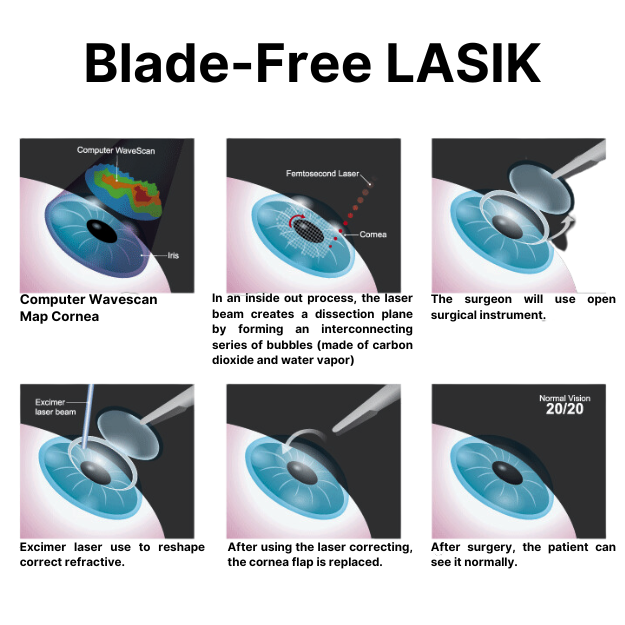Updated on February 20, 2024
What Is iLASIK and How Does It Work?


Vision Center is funded by our readers. We may earn commissions if you purchase something via one of our links.
Key Takeaways
- iLASIK is a laser vision correction procedure that uses an advanced technology called the IntraLase Method.
- This technology allows for blade-free flap creation. Compared to traditional LASIK, the iLASIK flap has a lower complication risk.
- LASIK and iLASIK treat vision imperfections like nearsightedness, farsightedness, and astigmatism. This eliminates or reduces the need to wear glasses or contact lenses.
- The average cost of an iLASIK procedure is $2,000 to $3,000 per eye. This is higher than the cost of LASIK due to the advanced technology and shortage of doctors trained in the procedure.
What is iLASIK Surgery?
iLASIK eye surgery or IntraLase LASIK is a blade-free laser vision correction surgery. It’s considered a LASIK improvement because it minimizes the complications of traditional LASIK surgery.1
A handheld microkeratome blade creates the corneal flap during traditional LASIK procedures. Although research shows that LASIK is highly successful, corneal complications are more common than with iLASIK.2

The iLASIK procedure eliminates the use of a sharp blade. Instead, it uses laser energy to create a thin flap. It’s ideal for patients with thinner corneas.3
iLASIK Procedure
Here’s what to expect before, during, and after an iLASIK procedure:
Before Surgery
Your eye doctor will conduct initial evaluations to deterxmine your candidacy. They will also discuss the benefits, risks, and expectations for laser vision correction surgery.
If you normally wear contact lenses, your eye doctor may recommend leaving them out for several days or weeks before surgery.
During Surgery
During the iLASIK procedure, you will sit in a reclining chair, and your doctor will clean your eye in preparation for surgery.
The procedure will involve the following steps:
Step 1: Mapping Your Vision
Your doctor will use wavefront technology to create a 3D map of your eyes. With wavefront mapping, your doctor can create an accurate personal vision profile.
The wavefront system uses the collected information to customize your vision treatment. The system then controls the excimer laser reshaping of your cornea.4
Step 2: Creating The Flap
Next, the thin flap is created using IntraLase®, an advanced femtosecond laser used for the iLASIK procedure exclusively. The laser can predictably create hinge locations, flap thickness, and diameter.5
The IntraLase femtosecond laser device produces rapid pulses of laser light, creating a layer of microscopic bubbles under the cornea. The bubbles enable your surgeon to lift the thin corneal flap and fold it back to perform the next step.
Step 3: Wavefront-guided Laser Vision Correction
This step is similar to the LASIK procedure but is computer-driven and uses more advanced software.
The wavefront system guides the excimer laser to reshape your cornea according to your needs. After your laser treatment, the surgeon will reposition the corneal flap to allow healing.
Ensure you have reliable transportation home as you may be unable to drive after surgery.
After Surgery
After iLASIK surgery, you may feel discomfort in your eye. In some cases, you may experience mild pain. Your doctor may prescribe pain medications and lubricating eye drops to help relieve discomfort and promote healing.
Go easy on your eyes after surgery. Avoid activities that strain your eyes, including reading or watching television. Doctors recommend keeping your eyes closed as much as possible.
Doctors highly recommend the first follow-up visit 24 hours after the surgery. This will enable your surgeon to monitor the healing process.
Side Effects & Risks of iLASIK Surgery
Some side effects of iLASIK include:
- Increased sensitivity to light
- Blurry vision
- Transient light sensitivity syndrome (TLSS); rare
- Decreased visual clarity immediately after surgery
- Gritty or burning sensation
- Infections
- Vision loss or serious changes, rare
- Flap healing problems
- Bloodshot eyes
Complications of iLASIK include:
- Bacterial, viral, or fungal infections
- Wrinkled flap
- Epithelial ingrowth
How Much Does iLASIK Cost?
This laser vision correction procedure typically costs between $2,000 and $3,000 per eye. The cost of iLASIK varies based on geographic location and the specific surgeon you visit.
iLASIK tends to cost more than LASIK because it uses more advanced technology. Additionally, more eye doctors are trained to perform LASIK than the iLASIK procedure. This drives up the price for doctors trained in the iLASIK procedure.
What Is the Difference Between iLASIK and LASIK?
iLASIK is considered less invasive, more accurate, and safer than traditional LASIK. The main difference between iLASIK and LASIK is the technology used:
- LASIK eye surgery uses a blade. The surgeon will create a corneal flap using a tiny, bladed microkeratome device.
- iLASIK is blade-free. It uses an IntraLase laser to create the corneal flap.
Differences in Treatment Scope
Traditional LASIK can only correct lower-order aberrations effectively. IntraLase LASIK can treat both lower and higher aberrations.
How much you see is determined by your lower-order and higher-order aberrations.6 Lower-order aberrations are also known as refractive errors. These include nearsightedness, farsightedness, and astigmatism.
How well you see is affected by higher-order aberrations. These abnormalities may cause poor night vision, glares, and halos. Higher-order abnormalities don’t necessarily have as significant of an impact on vision.
LASIK vs. iLASIK Pros and Cons
Here are the pros and cons of each procedure:
Pros of iLASIK
- Safer than LASIK
- Quicker recovery than traditional LASIK
- Eliminates microkeratome use
- Micron-level accuracy and precision
- Better visual outcomes (20/20 vision in most patients)
- Customizable to every patient
- Reduced need for LASIK enhancement
- Low risk of dry eye syndrome
Cons of iLASIK
- Risk of flap swelling
- Few surgeons can perform this procedure
- Risk of dry eyes, rare
Pros of Traditional LASIK
- Quick and safe procedure
- Immediate outcome (clear vision after 24 hours)
- No need for glasses or contact lenses
- Perfect 20/20 vision in most cases
Cons of Traditional LASIK
- Risk of under-correction or overcorrection
- May require LASIK enhancement if the desired outcomes are not achieved
- May develop corneal flap complications such as infections
- Not everyone is eligible
- Risk of dry eyes
- Nighttime glares and halos
- Requires post-op care to prevent complications
Results & Success Rates
Most iLASIK and LASIK patients achieve clear vision (20/20 or better). Research on LASIK patients also shows a high level of satisfaction after surgery.7
iLASIK is superior to traditional LASIK because it eliminates the complications caused by the blade. It has a higher success rate and a low potential for flap complications. The IntraLase Method is highly accurate since it’s computer-guided.
You must follow aftercare guidelines and make follow-up visits with your surgeon to ensure successful healing after surgery.
Is iLASIK Right For You?
This procedure may be right for you if you have good eye health and a refractive error, such as:
- Mild to severe nearsightedness (myopia)
- Farsightedness (hyperopia)
- Astigmatism (irregular eye curvature)
Additionally, good candidates for iLASIK will meet the following requirements:
- 21 years or older
- Don’t qualify for LASIK surgery, which requires a thicker cornea
- Good general health
- No eye diseases such as cataracts
- A stable vision prescription for at least one year
- Not taking any medication that may interfere with healing
- Desire to get rid of contact lenses or eyeglasses
Alternative Vision Correction Options
Other types of refractive eye surgery include:
- Implantable collamer lens (ICL) or Visian ICL
- Photorefractive keratectomy (PRK)
- Small incision lenticule extraction (SMILE)
- Intraocular lens implant (IOL)
- Refractive lens exchange surgery (RLE)
In this article
7 sources cited
Updated on February 20, 2024
Updated on February 20, 2024
About Our Contributors
Vincent Ayaga is a medical researcher and seasoned content writer with a bachelor's degree in Medical Microbiology. Specializing in disease investigation, prevention, and control, Vincent is dedicated to raising awareness about visual problems and the latest evidence-based solutions in ophthalmology. He strongly believes in the transformative power of ophthalmic education through research to inform and educate those seeking knowledge in eye health.
Dr. Melody Huang is an optometrist and freelance health writer with a passion for educating people about eye health. With her unique blend of clinical expertise and writing skills, Dr. Huang seeks to guide individuals towards healthier and happier lives. Her interests extend to Eastern medicine and integrative healthcare approaches. Outside of work, she enjoys exploring new skincare products, experimenting with food recipes, and spending time with her adopted cats.

